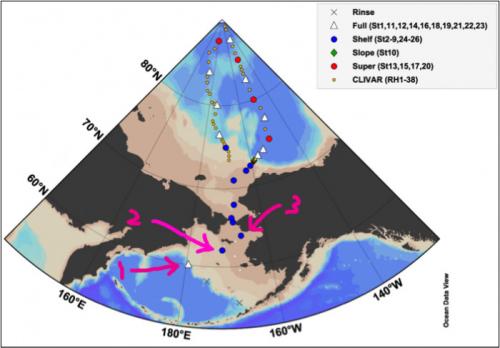Cruise Day 11
Speed 11 knots (kts)
Course 356° (N)
Location N. Chukchi Sea, approx. 250 nm NE of Wrangel Island, Russia
Depth 360 m
GO DEEPER DISCUSSION: (see previous journal for the questions.)
Walruses feed on sea-bottom organisms, especially clams, in fairly shallow water. They use their whiskers to feel through mud on the sea floor for their food.
TODAY’S JOURNAL:
We just concluded a very long station a little after 4 pm today near the outer edge of the Chukchi Shelf. (We started it around 11pm last night.) As we transit north to our next science station the water is rapidly deepening as we head off the Chukchi shelf into the southern end of the Makarov Basin. After consulting satellite ice imagery for a few weeks to get a sense of the dynamics in play this summer, and meetings between our chief scientists and Coast Guard officers, it has been decided that we will essentially reverse our originally planned cruise direction as we head into deep water. The plan now is to go north on the western leg of our planned cruise track, which roughly traces 180° longitude. We will return south along about 150° W longitude, the way we originally intended to go north. This is because the ice appears to be lighter along the 180° route, which will let us travel faster and conserve fuel as we go north. It will also give the ice along the 150° route time to melt and break up more before we travel back that way. The date when Arctic ice is considered to be at its annual minimum is 15 September, our target date for the North Pole or turning around to head back.
 Reversing the direction from the original cruise plan, we are now planning to run north along ~180°, and back south around ~150°W.
Reversing the direction from the original cruise plan, we are now planning to run north along ~180°, and back south around ~150°W.
The station we just concluded gave several of the sampling teams challenges. Things don’t always go according to plan in a tough environment such as the ice-littered Arctic Ocean we are traversing, but when something doesn’t work the team involved gets busy fixing/replacing gear or changing the plan to reach a successful outcome. For example, one of the pumps needed to bring water up from overboard malfunctioned this morning. The team using the pump worked with the ship’s electrical department to diagnose & fix the problem and were able to successfully deploy the pump this afternoon. Another team had trouble with an ice floe that drifted into their winch cable while they were conducting a CTD cast off the starboard side. The ice dragged the cable (and sampling rosette) aft, causing the cable to jump out of its pulley on the A-frame. When it all finally got free of the ice, a special cable-grabbing device was used to hold the weight of the rosette so the cable could be re-set properly in the pulley. The experience and skill of our scientists and technicians is especially evident as they solve problems like these to keep the expedition on target.
 Paul Aguilar & Mark Stephens work to repair a pump.
Paul Aguilar & Mark Stephens work to repair a pump.
Earlier in the cruise, the team running the GEOTRACES rosette sampling realized that their winch was having trouble smoothly operating in cold temperatures. Heating units were ordered to help the winch get the job done in the cold. Meanwhile, the Coast Guard crew identified a few critical parts needed tor the ship as we continue north. The solution to getting all of this on board was to have a US Coast Guard C130 cargo plane deliver them! The plane, based in Kodiak, Alaska, flew up to meet us today in the North Chukchi Sea. The plane circled the ship several times and then parachuted the parts down in a waterproof cask that landed a few hundred meters out from us in the sea. One of our small boats headed out to snag the parcel, and after one more salutary flyover the C130 headed back for Alaska. It was a very satisfying operation to watch, and demonstrated the capable hands we are in as we head deeper into the Arctic.
 A US Coast Guard C130 drops repair supplies to USCGC Healy in the N. Chukchi Sea.
A US Coast Guard C130 drops repair supplies to USCGC Healy in the N. Chukchi Sea.
 One of USCGC Healy’s small boats retrieves dropped supplies from the Kodiak, Alaska-based Coast Guard C130 cargo plane.
One of USCGC Healy’s small boats retrieves dropped supplies from the Kodiak, Alaska-based Coast Guard C130 cargo plane.
GO DEEPER!
September 15 is not the average warmest part of the Arctic Summer, but is the date when the Arctic ice is considered to be at its minimum. Why would the ice minimum be substantially later than the warmest part of the summer in July?
Aloft Con web cam updated every hour
Healy Track
That's all for now. Best- Bill

